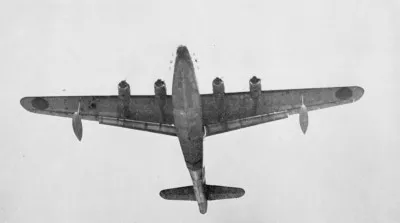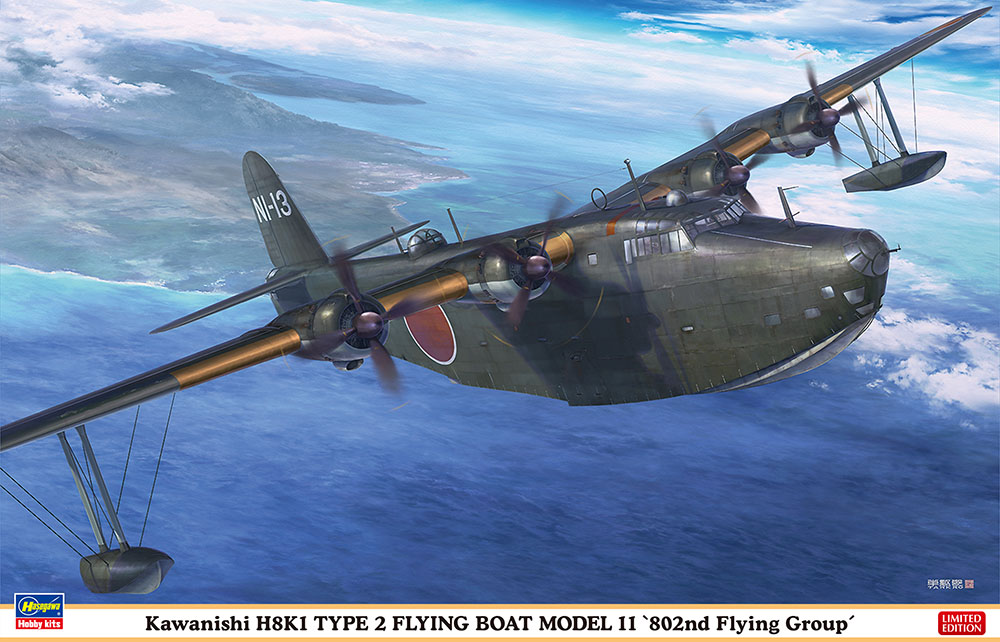- Yes
- No

Kawanishi H8K1 Model 11 (二式飛行艇一一型)
The Kawanishi H8K1 Model 11 is a Japanese flying boat commissioned in February 1942. 17 aircraft of this version were built, which probably served until the end of the war.
History
In 1938, the Japanese Navy Command decided that the Kawanishi H6K flying boats were not a sufficient force to help the Japanese fleet reduce the unjust dominance of the British and the Americans (this came from the division of the fleet tonnage created at the Washington Conferences of 1922 and the Londen Conference of 1930, which required the Japanese fleet to be weaker than the American or British fleet). The Japanese decided that they needed a new, heavily armed aircraft with a huge range. The new aircraft were to have powerful defensive armament due to flying without escort, which was not possible at such distances, and powerfully armed offensively, so that one aircraft would already be a threat to the enemy fleet. On April 18, 1938, specifications for the new aircraft were issued, which included the following points:
- Maximum speed: Over 240 knots (444 km/h)
- Cruise range: Over 7,400 km during reconnaissance and over 6,500 km during attack
- Powerful defensive fire, bulletproof armor, equipped with a large number of 20 mm cannons.
- Good maneuverability on par with small planes, facilitating torpedo hits.
- It can carry 1 ton of bomb or 2,800 kg of torpedoes.
To compete for a new long-range aircraft, Nakajima with a promising modification of the Douglas DC-4E aircraft and Kawanishi, who at that moment was starting the production of new Kawanishi H6K flying boats. The kawanishi plant faced the difficult task of meeting these requirements, but decided to build a flying boat, which in this case has its pros and cons. Flying boats don’t need airports and can even refuel in the middle of the ocean. However, due to their fuselage design, they have worse flight performance, because they offer greater aerodynamic drag. However, Kawanishi had a suitable man - Inrzynier Shizuo Kikuhara, who was an expert in flying boats and seaplanes (he designed the Kawanishi H6K). The design work was very delayed due to the excessive requirements of the Japanese Navy, in September 1939, due to the outbreak of war in Europe, tensions in the Pacific also increased, which caused Kawanishi to give a very high priority for the future H8K aircraft. It was assumed that the prototype of the aircraft had to be completed by the end of 1940. Shizuo Kikuhara and the rest of the personnel responsible for the project managed to fulfill this assumption and on December 29, 1940, the Kawanishi H8K prototype was ready, and a test flight took place on December 30. At the beginning, the plane struggled with various problems, for example, rudder, engine flooding or problems with large water splash. In March 1941, the modified prototype set off for further tests. The prototype H8K1 flying boat was becoming a very good aircraft faster and faster, compared to the competitive G5N1, which was constantly plagued by new problems. When two more prototype/pre-production H8K1 flying boats were delivered in December, the Japanese Navy was already determined to choose the H8K1 instead of the G5N1. On February 5, 1942, the H8K1 flying boat was accepted into the sluzba as the Type 2 Type 11 Flying Boat (二式飛行艇一一型). Along with the prototype and two pre-production aircraft, fourteen more production aircraft were produced by mid-1943. Few of these aircraft were built due to the high price and complexity of the design. At the end of 1943, an improved version designated H8K2 went into production. On March 4, 1942, two H8K1 flying boats made the second unsuccessful attack on Perl Harbor. In 1943, the H8K1 prototype was converted into a transport aircraft designated H8K1-L.
Construction description
The Kawanishi H8K1 is similar to the Kawanishi H8K2, but there are some important differences. I will try to present these differences here:
- Instead of the Mitsubishi MK4Q Kasei 22 engines with a take-off power of 1,380 kW (1,850 hp), the H8K1 has Mitsubishi MK4A Kasei 11 (Ha-32-11) engines with a take-off power of 1,125 kW (1,530 hp)
- The aircraft has weaker defensive armament. It has two Type 99 cannons (dorsal and tail cannon) and 5 Type 92 machine guns (in the nose, two in the cockpit, once in the side positions behind the wings)
- The nasal mouse has a different shape
- The aircraft has smaller fuel tanks (by 1760 liters)
- The plane’s pace is weaker, but not too much
- H8K1 planes have the H-6 radar (compared to the H8K2 from the game, which does not have it, although it could)
General characteristics
- Crew: 10
- Length: 28,118 m
- Wingspan: 37,969 m
- Height: 9,144 m
- Wing area: 160,00 m2
- Empty weight: 15502 kg
- Take-off Weight: 24500 kg
- Maximum Take-off Weight: 31000 kg
- Powerplant: 4 x Mitsubishi Meisei Type 1/2 (Myojo 1/2), air-cooled nine-cylinder radial engine with a take-off power of 588 kW (800 hp)
- Propellers: Three-bladed propeller, metal, with adjustable angle of attack, diameter 3,600 mm
Performance
- Maximum speed: 433 km/h
- Cruise Speed: 296 km/h
- Range: 4720 km
- Maximum Range: 7200 km
- Service ceiling: 7630 m
- Time to Climb to: 11,53 min to 5000 m
- Climb Rate: 7,7 m/s
Armament
- Guns:
- 1 x Type 99 Model 1 20 mm dorsal cannon (450 rounds)
- 1 x Type 99 Model 1 20 mm cannon in tail gun (450 rounds)
- 1 x Type 92 7.7mm machine gun in the nose (970 – 1,064 rounds)
- 2 x Type 92 7.7mm machine gun in cockpit (970 – 1,064 rounds)
- 2 x Type 92 7.7mm machine gun behind the wings on the sides of the fuselage (970 – 1,064 rounds)
- Bombs:
- 2 x 800 kg bombs (under the wings)
- 8 x 250 kg bombs (under the wings)
- 16 x 60 kg bombs (under the wings)
- 2 x 800 kg torpedo (under the wings)
Additional equipment
- H6 Radar
Special thanks
Summary
The Kawanishi H8K1 Model 11 is an interesting flying boat for Japan in War Thunder. This aircraft will be a useful bomber with a lower br than the current Kawanishi H8K2. The plane still has great defensive armament, and a huge load of bombs, which will be useful in air battles. In addition, as a flying boat, it will be useful in naval battles. I encourage you to discuss in the comments and to share your own knowledge on this subject.
Finally, I apologize for the linguistic and logical errors because unfortunately English is not my main language and I had to use google translator.
Internet sources
二式飛行艇 - Wikipedia
二式飛行艇/川西Kawanishi H8K | 大日本帝国軍 主要兵器
KAWANISHl Type2 Flyingboat
Kawanishi H8K - Wikipedia
Kawanishi H8K ‘Emily’
Kawanishi H8K (Emily): Photos, History, Specification
History Development Kawanishi H8K | War Thunder Wiki
Warplanes of Japan: Kawanishi H8K
Imperial Japanese Aviation Resource Center - A Warbirds Resource Group Site*
Operation K: The Lesser-Known Japanese Attack Against the US Pacific Fleet
Kawaniši H8K1 11 [Emily] : Kawaniši / Šin-Meiwa
Kawanishi H8K
Уголок неба ¦ Kawanishi H8K
Book sources
- Japanese Aircraft of the Pacific War page 307-317

Thank you for reading the suggestion, see you in the next one. Good luck pilots























